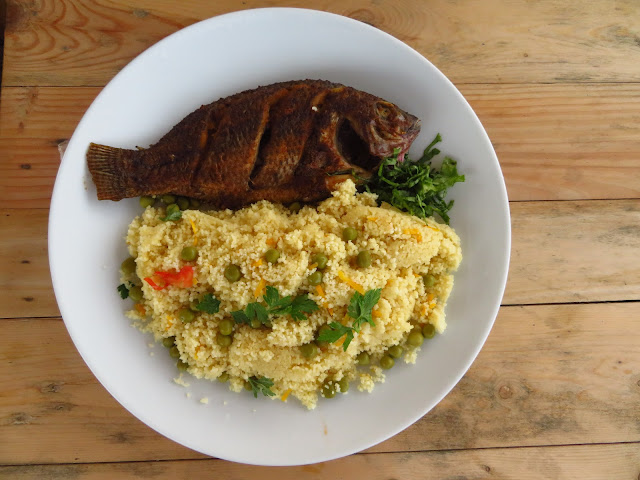An introduction to Beninese cuisine
My exposure to African cuisine is quite limited. There was that random lunch at Le Kilimanjaro in Newtown (upon searching, I learned that this restaurant has since closed). Then there's Asmara Restaurant in Oakland. So, to improve my exposure to this continent's food culture (I know, job hazard), I just had to try Beninese cuisine when I stumbled upon it.
The first thing I noticed? The food choices I made were not as exotic as I was expecting (thanks to the Ethiopian food I've tried previously). It's almost like eating Filipino food!
I tried fried golden tilapia. But instead of pairing it with steamed rice, I ate the fish with a mix of couscous, green peas, and carrots. The couscous reminded me of that time (many years ago) I was with Ate Maddie, Kuya Mitchie, Anna, and Biboy at Cafe Mediterranean in Rockwell. Kuya Mitchie definitely didn't enjoy the couscous... and I understand now why: we don't know how to properly prepare couscous! The couscous I tried with the tilapia was so yummy! I was just surprised at the serving size of the couscous... I'd grow fat if I keep eating this much!
Les Rives de Toho
I tried another fish dish, grilled sole. But instead of eating it with a cereal staple, I opted to try it with some of my fave vegetables, green beans that have been sautéed with garlic and butter. I eat sole but I've never been served a whole fish before! I haven't realised, until now, that sole is quite a huge fish! The green beans were a welcome change to my usual staples. Another delicious pairing, in my books.
Maquis du Port
The dishes that were most foreign to me were the fufu and the cheese cooked in tomato sauce. The fufu is mashed yam made into a paste. It reminds me of poi, a dilute paste of cooked taro flour that I've first encountered in Honolulu. The fufu is more of a thick paste... with a flavour that I found to be more acceptable than poi. Perhaps, this is because the starch used in fufu is yam. Taro has a flavour that I am not used to tasting. On the other hand, the cheese-tomato sauce dish reminds me of spaghetti sauce. Yes, another thumbs' up for me. The soft mild cheese used is known locally as amo (in Fon) and as wagasi. Its taste and texture remind me of the kesong puti that I typically eat with pan de sal when I visit Tita Mely in Sta Cruz.
Bar Maquis Deesse de Saveurs





Comments
Post a Comment
Thank you for dropping by!
Before moving on, please share your thoughts or comments about the post. :)
Thanks again!